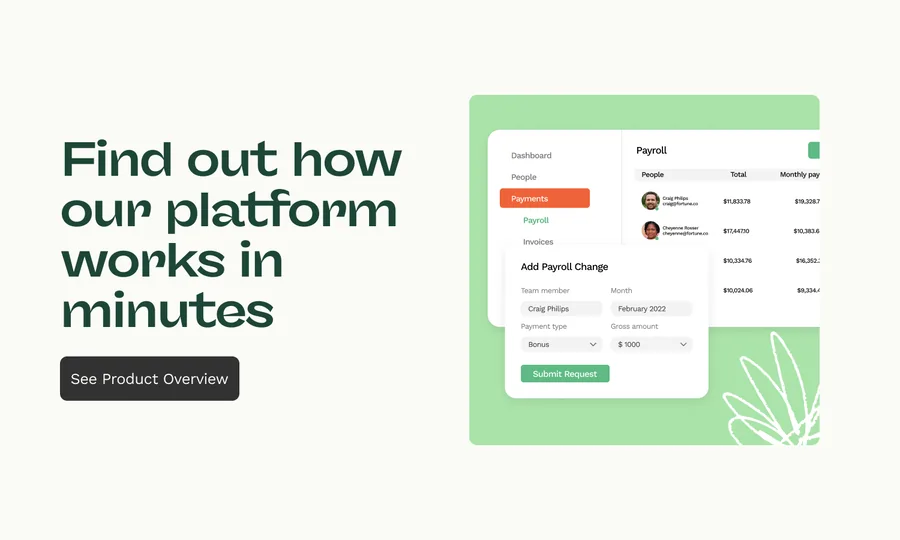What is a time-off request form?

Time-off request form
A time-off request form is a document used in human resources (HR) management that is designed to streamline the process of employees seeking temporary leave from work. This standardized form enables employees to formally submit their request for vacation, personal days, or other types of absences, including sick leave—a benefit that is increasingly common, with 75% of private industry workers having access to paid sick leave as of March 2020. It typically requires information such as the employee's name and department, the reason for the time off, and the desired duration.
Interested in Oyster but want more information about how the platform works? This product overview should help.
The form also facilitates clear communication between employees and their supervisors, ensuring that appropriate coverage is arranged. No matter the length of the employee's leave, having a system in place for tracking attendance allows departments to ensure business continuity.
Information required on an employee time-off request form
So, what information does a time-off request form actually collect? These forms gather essential details to process leave requests efficiently and maintain proper documentation.
Employee details: Full name, employee ID, department, and job title.
Type of leave: Vacation, sick leave, personal day, bereavement, or other.
Leave duration: Start and end dates of the requested time off, along with the total number of workdays.
Reason for absence: A brief explanation, if required by company policy, to provide context for the request. Note that some reasons for absence, such as Family Medical Leave Act (FMLA) requests, may require separate documentation. Under FMLA, eligible employees can take up to 12 workweeks of leave for reasons including the birth of a child, a serious health condition, or to care for a family member.
Contact information: The employee's preferred method of communication during their absence, such as phone and/or email.
Backup plan: Details of a team member who can cover responsibilities during the employee's absence.
Manager approval: A designated space for a supervisor's signature or electronic approval indicating their consent.
HR review: A section for HR personnel to confirm adherence to company policies, track the remaining leave balance, and record additional notes.
Date submitted: To ensure timely processing and to avoid scheduling conflicts.
Time off request form templates
Need a template to get started? Here's a basic time off request form that balances simplicity with completeness:
Employee Name: ___________________________
Employee ID: ___________________________
Department: ___________________________
Today's Date: ___________________________
Type of Leave Requested: ☐ Vacation ☐ Sick ☐ Personal ☐ Bereavement ☐ Other: _________
Start Date of Leave: ___________________________
End Date of Leave: ___________________________
Total Number of Days/Hours: ___________________________
Comments/Reason (Optional): ___________________________
Employee Signature: ___________________________
Manager Signature (for approval): ___________________________
Key benefits of this template:
Easy to customize: Adapt fields to match your company policies
Complete coverage: Includes all essential information for processing
Simple format: Clear layout that anyone can understand and fill out
Digital vs printable time off request forms
Choosing between digital and printable forms? Here's what works best for different situations:
Digital Forms | Printable Forms |
|---|---|
✓ Remote and distributed teams | ✓ Manufacturing or field environments |
The good news? Many companies use both approaches, giving teams flexibility based on their specific needs and preferences.
Reasons to use a printable time-off request form
While an electronic system has many benefits, there are times when a printable time-off request form makes more sense. Here are several advantages for organizations and employees alike.
Tangible records: Physical copies facilitate easy filing and archiving for future reference, ensuring accurate documentation for HR compliance and auditing purposes.
Ease of use: Printable forms are simple to complete and submit, providing a user-friendly experience for employees across varying levels of digital proficiency.
Universal accessibility: With no reliance on internet connectivity or software, printable forms are accessible to all employees, eliminating technological barriers and glitches.
Visual clarity: A well-structured, printed form enables managers and HR personnel to quickly review and assess leave requests, streamlining decision-making.
Reduced miscommunication: Printed forms standardize the time-off request process, minimizing potential misunderstandings and promoting clear communication.
Signature validation: Physical forms allow for traditional signatures, adding a personal touch to the approval process and increasing accountability across the board.
Backup documentation: In case of system failures or data loss, hard copies serve as a valuable backup.
How to review a request for time off form
Requiring a request for time off form is just the start. As an HR professional, executive, or company owner, you must have a clear process for reviewing these requests. Here's what you can do:
Assess for completeness: Verify that all required fields are filled out, ensuring that the form provides comprehensive information.
Confirm eligibility: Cross-check the employee's leave balance, adhering to company policies and any legal regulations. For FMLA, this includes verifying that the employee has worked for the employer for at least 12 months and has at least 1,250 hours of service in the preceding 12 months. Be sure to verify whether the request for planned time off was submitted within the proper time frame based on company policies; for example, FMLA requests generally require employees to give notice at least 30 days in advance when the leave is foreseeable.
Consider workload: Evaluate the employee's current projects and deadlines to determine the impact of their absence on team productivity.
Analyze staffing needs: Determine if adequate coverage is available during the requested period.
Review backup plan: Ensure that a viable handover strategy is in place to minimize potential disruptions.
Prioritize fairness: Examine previous leave requests and approvals to maintain equitable treatment among staff.
Communicate promptly: Inform the employee of the decision in a timely manner so that they can make necessary arrangements.
Document the outcome: Record the approved or denied request in the employee's file, track leave balances, and establish a historical record.
Beyond individual requests, you'll need clear policies for common scenarios:
Overlapping requests: First-come, first-served or seniority-based systems
Peak periods: Summer vacation and holiday request management
Emergency requests: Last-minute time off procedures
Protected leave: FMLA and ADA accommodations require separate tracking
Streamline global leave management with Oyster
Here's the thing—having a solid time off request process isn't just about paperwork. It's about building trust and keeping operations smooth when people need time away.
Managing global teams? That's where things get complex. Different countries mean different leave laws, holidays, and cultural expectations.
Oyster's platform handles this complexity by automating leave tracking according to local laws across 180+ countries. Start hiring globally and let us manage the legal requirements while you focus on your team.
 FAQs
FAQs
How do you write a time off request?
Include your name, specific dates needed, type of leave, and any coverage arrangements. Submit with as much advance notice as your company policy requires.
How do you fill out a PTO request form?
Complete all required fields including personal details, dates, and leave type, then double-check accuracy before signing and submitting.
Can my boss deny my time off request?
Yes, employers can deny requests based on business needs like deadlines or insufficient coverage. However, some leave types (like FMLA) are legally protected, so check your local labor laws. For instance, FMLA provides eligible employees with up to 26 workweeks of leave to care for a covered servicemember with a serious injury or illness.
About Oyster
Oyster enables hiring anywhere in the world—with reliable, compliant payroll, and great local benefits and perks.

Related Resources




.avif)






